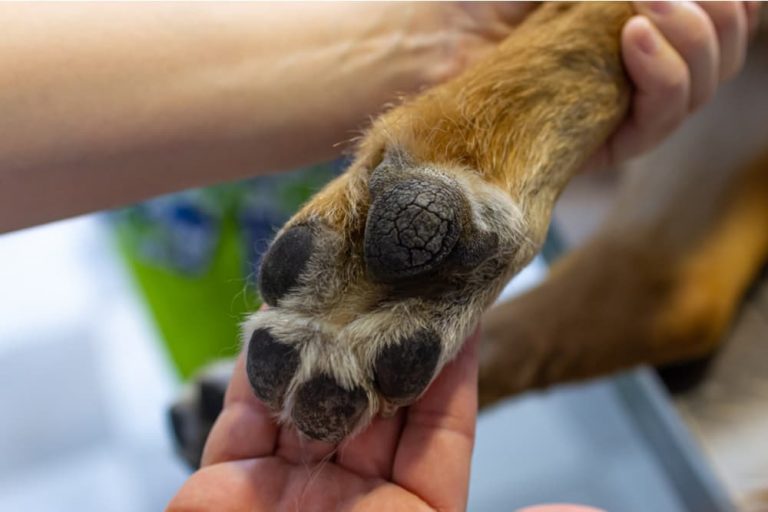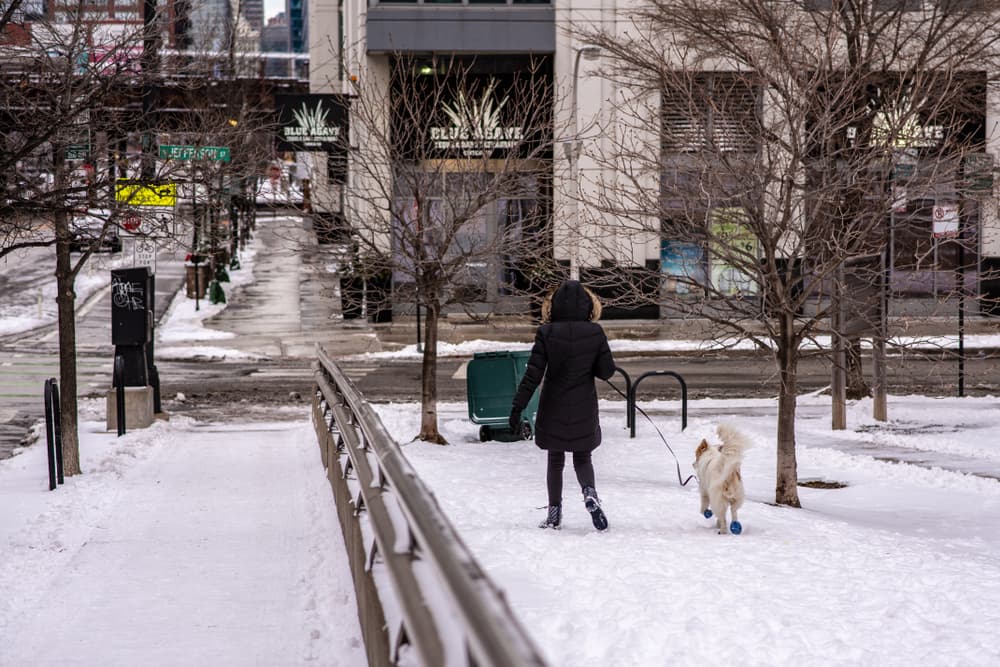Cracked Dog Paws: Tips and Treatments

When you notice your dog licking at dry and cracked paws or limping during walks, it’s normal to be concerned. What’s going on? Do cracked paws hurt dogs? And if so, how can you help your pup feel better as soon as possible?
“Cracked and dry paws are not uncommon in dogs and can cause both pets and owners some distress,” says Dr. Linda Simon, a veterinarian based in the U.K. Paw health is important for dogs, and dry and cracked paw pads could signal anything from excess dryness to an underlying health condition. Typically, though, they’re easy to treat.
Read on to learn what causes rough, cracked dog paws, signs of trouble to look out for, how to treat them, and when to contact a veterinarian for help.
Why Are My Dog’s Paws Cracked?

“Dry, cracked paws can be caused by many different issues, typically stemming from where your dog walks on a frequent basis and the environment you live in,” says Dr. Megan Conrad, a veterinarian based in Oregon.
Cold weather is one of the most common triggers for dried-out paws. In winter months, a combination of indoor heating, snow, and ice can zap moisture from your dog’s skin.
Summer’s heat could also spell trouble for dog paws. Surfaces like hot sand or pavement can rapidly dry them out and result in hard calluses that crack more easily. Dogs who often take a dip in the pool or the ocean may be even more prone to problems since both chlorine and salt dry them out.
Another common culprit? “Dogs lick their paws frequently in an attempt to soothe itchy paws due to allergies, and may find themselves with red, irritated, inflamed paws,” says Dr. Conrad. Breeds like Beagles, Bichon Frise, West Highland White Terriers, and Poodles are especially susceptible to this problem, according to the American Kennel Club Canine Health Foundation (AKCCHF).
Other potential reasons for dry, cracked paws in dogs include:
- Acral lick dermatitis (lick granuloma), excessive licking at paws due to boredom, stress, or compulsiveness
- Gaps in nutrition due to poor diet, gastrointestinal disease, or liver disease
- Hyperkeratosis, a common and typically harmless thickening of skin around paws and nose, especially in senior dogs
- Pemphigus foliaceus (PF), an autoimmune condition that causes crusty skin, pustules (pimples), and ulcers
Symptoms of Cracked Dog Paws

Numerous signs could clue you in that something’s wrong with your dog’s paw pads. You may notice:
- Rough, cracked, or peeling skin on paws
- Redness and swelling
- Licking or chewing at paws
- Holding a paw up
- Limping or sudden trouble walking
- Bleeding
- Brown staining of the fur around the paw pads or toes
- Abnormal or foul odor from the paws
Do Cracked Paws Hurt Dogs?

This section features an affiliate link, meaning GreatPetCare may earn a small commission if you click through and make a purchase.
Just as dry skin and chapped lips tend to hurt us, cracked paws tend to be painful and frustrating for dogs, too.
If your dog has dry, cracked paws they just won’t leave alone or other concerning symptoms like redness, swelling, odor, yellow or green discharge, or bleeding, schedule an appointment with a veterinarian. They can help you figure out what’s at the root of the problem and get the proper cracked dog paw pad treatment, says Dr. Conrad.
Cracked dog paws can pop up when you least expect them. And if your pup requires an unexpected visit to the veterinarian, that means vet bills can pop up, too. Having a pet health insurance plan in place to help cover such costs can provide pet parents with peace of mind. For example, plan options from Spot Pet Insurance include accident and illness coverage, diagnostic tests, emergency care, and more.
On the other hand, if you’re only seeing a little dryness and cracking, you can try to treat them at home first.

- Affordable, customizable options.
- 30-day money-back guarantee.
- Coverage for alternative therapies such as acupuncture.
How to Treat Cracked Dog Paws

“Dogs are usually excellent at healing and should find their paws naturally improve over time,” says Dr. Simon.
Here’s how to support the healing process:
Step 1: Clean paw pads with lukewarm, soapy water to remove any irritants. Rinse well and pat dry.
Step 2: Apply a dog-friendly paw balm or moisturizer (e.g., Musher’s Secret) according to the label instructions before going out to play and in the evening. Rub it in as much as possible.
Step 3: Use a temporary buster collar to ensure they don’t chew or lick at their paws if necessary.
Also, pay attention to what may cause dry paws. For some dogs, this is an ongoing issue—especially during cold winter months. Being prepared with dog paw balm can help ease symptoms of cracked paws early.
How to Prevent Cracked Dog Paws

It’s not always possible to prevent paws from cracking, but these strategies can help ensure you’re doing your best to protect your best bud.
Apply a Paw Balm
Apply a paw balm before you head outside to keep your dog’s feet safe in all types of weather. In addition to protecting paws from damage, the balm will help moisturize and sooth dry, cracked paws.
Put on Booties
Dog boots may take some getting used to (see: hilarious TikTok and YouTube videos of stomping doggos). But they’re one of the best tools available to protect paws from hot, cold, and rough terrain as well as ice and irritating de-icing products on the ground.
As you introduce your pup to them, make sure to reward her for good behavior with plenty of treats, pets, and praise.
Trim Fur Around Paws
If dog boots are too much of a hassle, there are other options. You can keep snow and ice balls from drying out paws by keeping fur around toes clipped short.
Skip Tricky Terrain
“If you can’t hold your hand against the street for 5 seconds, it is too hot for your dog to be out on,” says Dr. Simon. To avoid painful blisters and burns, don’t walk your dog on rough terrain without boots, and never take her out on hot pavement, sand, or roads.
Ensure Your Dog is Well-Nourished
Check in with your veterinarian to make sure your dog is on an appropriate diet that contains all of her required nutrients for her age and health status. Ask about whether you should start her on a skin and coat supplement too, suggests Dr. Simon.
Do Regular Paw Checks
Check your pup’s paws after long walks in the woods or games of fetch to remove any burrs or pieces of grass, take note of cracks or injuries to treat, and—during winter months—wipe them off in case of exposure to de-icing agents or other chemicals (like antifreeze) on the ground. If her paws look dried out, apply a balm or moisturizer after cleaning them off.
While dry, cracked paws can be a nuisance, they’re usually easy to treat with a little TLC.









